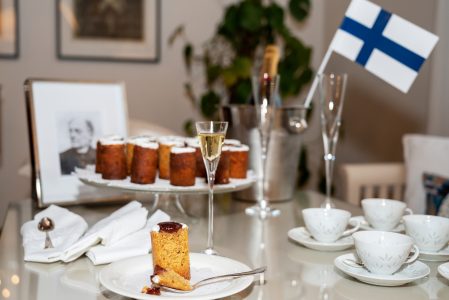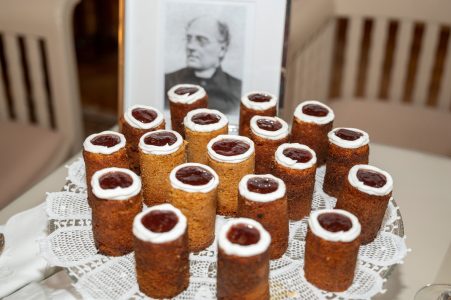In the first days of February 2021, when the pandemic circumstances were still dominating the life in Belgrade and the rest of the world, DC had an exclusive honor to be invited to the Finnish residence in Belgrade and to interview an amazing lady – Mrs. Pia Kaikonen who opened the doors of her Serbian home away from home and shared some of the interesting cultural and gastronomy information about her home country in the North-The amazing Finland!

What are the famous food specialties of Finland?
Finland has very rich culinary traditions. A little bit the same way as here in the Balkans where the east meets the west. This is reflected, for example, in the way how we mix sweet and savory tastes together. As a cold country, we cook many dishes in the oven, as especially in the old days that was a functional way to combine heating and cooking. Good examples of this are the various vegetable casseroles. We also use quite a lot of spices, which might be surprising. In the medieval times Estonian capital Tallinn, on the southern shore of the Gulf of Finland, was a big spice trading city. For example, in vegetable casseroles we use syrup, peppers, ginger, cinnamon, anis, liquorice etc.
A good example of Finns’ love for spices nowadays is the fact that Finland is the largest exporter of cumin in the world. It’s wonderful to think that when an Indian or American family sits at the dinner table, they can taste the deep aroma of the cumin that has grown under the endless, cool, northern summer sun.
Do you or your chef prepare some Finnish dishes here in Belgrade?
When we entertain guests, we always serve also Finnish specialties. As Finland has 187,888 lakes and also a long sea coastline, we love to serve Finnish fish. In addition to fish, we also serve game and other oven prepared meat dishes such as Karelian stew, overcooked lamb (“särä”), but also many vegetarian dishes, such as root celery liquorice soup. For cocktail bites we serve, for example, “porkkala”, which is savory, fermented vegan dish made of carrots, celery or beetroot.
Finland is the largest exporter of cumin in the world. It’s wonderful to think that when an Indian or American family sits at the dinner table, they can taste the deep aroma of the cumin that has grown under the endless, cool, northern summer sun.
We heard that Finns love cakes- true or false?
Oh, yes – Finns are cake lovers. We honor many of our important national figures with special cakes named after them. It is also quite popular to go to cake buffets during weekends, where you can enjoy as much as you like both sweet and savory cakes.

What is your favorite Serbian food?
My favorite is buckwheat pie that I ate when we were visited Uvac. I love strong Pirot cheese. You really can find the tastes of different flowers and herbs in it.
What is life like in Belgrade?
Our life here is quite relaxing and culturally rich. At this moment social life is very limited but at normal times it’s vibrant. Even a northern introvert gets positive energy and action here.
Tell us about a special cake dedicated to a Finnish poet.
Valentine’s Day is a newcomer in Finland from around 1980: ies. It was added to our calendar recently; in 1996. Somehow, we have turned it to be more a day of friendship rather of lovers. But of course, nowadays chocolate and flowers are given as presents.
Our life here is quite relaxing and culturally rich. At this moment social life is very limited but at normal times it’s vibrant. Even a northern introvert gets positive energy and action here.
A more traditional cake served at this time of year is the Runeberg cupcake.
Mr. Johan Ludvig Runeberg was born on 5th of February, 1804, and he died on 6th May, 1877. He is the national poet of Finland and the author of the lyrics to “Our Land”, that became the Finnish national anthem. Runeberg cupcake is a Finnish pastry flavored with almonds and arrack or rum and weighing about 100 grams. It usually has raspberry jam encircled by a ring of icing on top. Runeberg regularly enjoyed the cupcake with punsch for breakfast. Runeberg cupcakes are typically eaten only in Finland and are generally available in stores from the beginning of January to Runeberg’s birthday on February 5; however, Porvoo, where Runeberg lived for most of his life, is an exception, as some of its cafés tortes are available every day of the year. Runeberg’s wife, Fredrika Runeberg, created the dessert. Her recipe book from the 1850s has a recipe for the cupcake, believed to be a variation of an earlier recipe by confectioner Lars Astenius from Porvoo.
As Finland has 187,888 lakes and also a long sea coastline, we love to serve Finnish fish.

RUNEBERG’S CUPCAKES
Batter:
1 egg
25 ml sugar
50 ml brown sugar
100 g butter
50 ml cream
200 ml flour
1 tsp baking powder
50 g ground almonds
(50 ml cinnamon cookies)
1 tsp vanilla
½ tsp almond essence
(a dash of almond liqueur — eg “Amaretto”)
sugar syrup:
100 ml sugar
50 ml water
1 – 2 tbsp (or to taste) punsch, rum or cognac
raspberry topping:
100 ml raspberry jam
sugar icing:
icing sugar
water
dash of almond essence
Traditionally, the dough for these cakes is baked in special “Runeberg’s tart moulds”, sold in many Finnish stores.
The individual moulds are bottomless cylinders about six centimetres tall and with a diameter of about five centimetres. When baked in these genuine moulds, the cakes are called by their proper name, “Runeberg’s tarts”.
Picture on right: a homemade Runeberg’s tart baked in a traditional mould (seen in the background).
Melt the butter and let it cool slightly. Whip the cream until soft peaks form. Beat the egg and sugars until fluffy, add almond essence (and liqueur), melted butter and whipped cream.
Mix together the dry ingredients. If you do not have cinnamon cookies, walnuts or hazelnuts at hand, you can omit them or replace them with ground or chopped almonds. Gently fold the dry ingredients into the batter.
Lightly butter eight small (90 ml / 3 fl. oz) cylindrical moulds and spoon the batter into them. Place the moulds on a baking sheet and bake the cakes at 175 – 200 °C for 15 – 20 minutes or when a cake tester/toothpick inserted in the middle of them comes out clean.
Meanwhile, prepare the sugar syrup and raspberry topping. Place the sugar, water and the alcohol of your choice into a small saucepan. Bring the mixture to the boil, so that the sugar melts and alcohol evaporates. Remove from heat and set aside.
Take the hot cakes out of the oven, prick them with a toothpick, and drizzle the warm sugar syrup on top of them. Use all of the syrup. Let the cakes absorb the syrup for half an hour or longer. When the cakes seem thoroughly moist, gently remove them from the moulds and flip them over.
If the bottoms of the cakes are uneven, cut them flat carefully, using a serrated knife, so that the cakes will stand straight. This is most easily done while the cakes are still inside the moulds. Cut by moving the knife along the rim of the mould.

Cut a small round hole on the top of the cakes using a small teaspoon (see the picture on below left). Fill the holes with raspberry topping and let it set in refrigerator.
Meanwhile, prepare a very stiff sugar icing by mixing a dash or water with icing sugar. Flavour the icing with a dash of almond essence. Pipe the icing around the raspberry topping on top of the cakes . Let the sugar icing set and serve the cakes with coffee or tea.
Makes about 8 small cakes.
Recipe source: family recipe/traditional Finnish recipe.